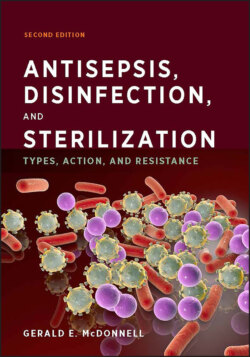Читать книгу Antisepsis, Disinfection, and Sterilization - Gerald E. McDonnell - Страница 3
List of Tables
Оглавление1 Chapter 1TABLE 1.1 Examples of various types of microorganismsTABLE 1.2 Some advantages and disadvantages of microorganismsTABLE 1.3 Comparison of general prokaryotic and eukaryotic structuresaTABLE 1.4 Helminths associated with diseaseTABLE 1.5 Examples of common fungiTABLE 1.6 Classification of protozoa, based on their motility mechanisms and mic...TABLE 1.7 Examples of pathogenic mycoplasmasTABLE 1.8 General differentiation of types of bacteria based on their microscopi...TABLE 1.9 Examples of gram-positive bacteriaTABLE 1.10 Examples of gram-negative bacteriaTABLE 1.11 Cell wall structures in mycobacteria and related organismsTABLE 1.12 Examples of extremophile archaeaTABLE 1.13 Viral families, with examples of classifications, including size, pre...TABLE 1.14 Examples of viral diseasesTABLE 1.15 Examples of bacterial, fungal, and algal toxinsTABLE 1.16 Common examples of bacterial exotoxinsTABLE 1.17 Examples of surrogate microorganisms used to test and verify antimicr...TABLE 1.18 Examples of standardized suspension testsTABLE 1.19 Examples of standardized carrier testsTABLE 1.20 Examples of simulated-use and/or in-use tests and/or guidelinesaTABLE 1.21 Bacterial-endospore species used to monitor and validate sterilizatio...TABLE 1.22 Examples of biological-indicator standardsTABLE 1.23 A typical classification of chemical indicatorsTABLE 1.24 Examples of chemical-indicator standardsTABLE 1.25 Examples of standards and guidelines for antisepsis, disinfection and...TABLE 1.26 Various constituents of formulated biocidal productsTABLE 1.27 Examples of process variables in various disinfection/sterilization t...TABLE 1.28 Various components of cleaning formulationsTABLE 1.29 Examples of common water contaminants and their effects
2 Chapter 2TABLE 2.1 Examples of various standards and guidelines for heat disinfectionTABLE 2.2 Wavelengths and energies of types of electromagnetic radiationTABLE 2.3 Types of UV radiationTABLE 2.4 IR wavelength rangeTABLE 2.5 Typical uses of filtration for liquid and gas applicationsTABLE 2.6 Classification of clean rooms based on number of ≥0.5-μm particles det...TABLE 2.7 Examples of standards and guidelines for disinfection and sterilizatio...
3 Chapter 3TABLE 3.1 Examples of various guidelines and standards on the use and applicatio...TABLE 3.2 Various types and sources of essential oilsTABLE 3.3 Other oxygen- and hydrogen peroxide-releasing compoundsTABLE 3.4 Comparison of sporicidal efficacies of liquid and gaseous hydrogen per...TABLE 3.5 Hydrogen peroxide-based synergistic formulations and processesTABLE 3.6 Various types of phenolic compoundsTABLE 3.7 Classification of surfactantsTABLE 3.8 Various biocides used on antimicrobial surfacesTABLE 3.9 Various types of proteins, peptides, and enzymes used as biocides
4 Chapter 4TABLE 4.1 Common or notable infections of the skinTABLE 4.2 Examples of various guidelines and standards on the use and applicatio...TABLE 4.3 Examples of biocides most widely used as skin antiseptics and washesaTABLE 4.4 Miscellaneous biocides used as antiseptics and their applications
5 Chapter 5TABLE 5.1 Common steam contaminants and their effectsTABLE 5.2 Typical qualities of WFI and “clean” steamaTABLE 5.3 Typical steam sterilization cyclesTABLE 5.4 Examples of standards and guidelines for steam sterilization applicati...TABLE 5.5 Typical steam sterilization cycles recommended for TSE-associated deco...TABLE 5.6 Examples of bacterial-spore resistance to dry heat at 160°CTABLE 5.7 Materials disinfected and/or sterilized by radiationTABLE 5.8 Typical doses of radiation for biocidal applicationsTABLE 5.9 Examples of standards and guidelines for radiation sterilization appli...
6 Chapter 6TABLE 6.1 Typical ethylene oxide sterilization process conditions, based on FDA-...TABLE 6.2 Examples of standards and guidelines for EO sterilization applicationsTABLE 6.3 Examples of standards and guidelines for LTSF sterilization applicatio...TABLE 6.4 Comparison of STERRAD hydrogen peroxide gas-plasma sterilization syste...
7 Chapter 7TABLE 7.1 Comparison of anti-infectives and biocidesTABLE 7.2 Widely used antibiotics (antibacterials) and their mechanisms of actio...TABLE 7.3 Widely used antifungal drugs and mechanisms of actionTABLE 7.4 Widely used antiviral drugs and mechanisms of actionTABLE 7.5 Widely used antiparasitic drugs and mechanisms of actionTABLE 7.6 Biocides with an oxidizing-agent-based mode of actionTABLE 7.7 Examples of products observed on reaction of oxidizing agents with ami...TABLE 7.8 Biocides with cross-linking- or coagulation-based modes of actionTABLE 7.9 Biocidal processes with transfer-ofenergy-based modes of actionTABLE 7.10 Biocides that act by disrupting the structures and functions of macro...
8 Chapter 8TABLE 8.1 Examples of intrinsic and acquired mechanisms of resistance to biocide...TABLE 8.2 Examples of bacterial responses to environmental stressTABLE 8.3 Differences observed in the expression of proteins during the hydrogen...TABLE 8.4 Classification of active-transporter systemsTABLE 8.5 Examples of bacterial efflux systems that have been shown to extrude b...TABLE 8.6 Protective cell surface structures external to the bacterial cell wallTABLE 8.7 Typical bacteria and fungi associated with biofilm formationTABLE 8.8 Biofilms and microbial response to antimicrobial agentsTABLE 8.9 Examples of known extreme resistance to biocides and biocidal processe...TABLE 8.10 Spore-forming bacteria and their significanceTABLE 8.11 Sporistatic and sporicidal concentrations of liquid biocidesaTABLE 8.12 Structures, components, and activities of endospores and their vegeta...TABLE 8.13 Examples of revival mechanisms that have been described following bio...TABLE 8.14 Ranges of MICs and MBCs of chlorhexidine and triclosan against S. aur...TABLE 8.15 MICs of various biocides (determined in test media) for gram-positive...TABLE 8.16 Possible transport mechanisms of some biocides into gram-negative bac...TABLE 8.17 Acquired mechanisms of resistance to antimicrobial drugsTABLE 8.18 Examples of RND efflux pumps associated with biocide resistance in P....TABLE 8.19 Examples of mutations causing increased sensitivity to biocidesTABLE 8.20 Identified and possible mechanisms of plasmid-encoded resistance to b...TABLE 8.21 Examples of acquired (plasmid or transposon) resistance to mercury in...TABLE 8.22 Examples of plasmid-mediated resistance to silver and copper in bacte...TABLE 8.23 Plasmid-mediated resistance to various toxic metals in bacteriaTABLE 8.24 Examples of qac genes and susceptibilities of S. aureus strains to bi...TABLE 8.25 qac genes and resistance to QACs and other biocidesTABLE 8.26 Viral classification and response to biocidesaTABLE 8.27 Effects of various disinfection and sterilization methods on prionsTABLE 8.28 Possible mechanisms of fungal resistance to biocidesTABLE 8.29 Comparison of the relative resistances of bacteria and fungi to bioci...TABLE 8.30 Fungicidal concentrations of biocides for yeasts and moldsTABLE 8.31 Various cell wall structures of fungiTABLE 8.32 Parameters affecting the response of S. cerevisiae to chlorhexidineTABLE 8.33 Examples of spores produced by fungiTABLE 8.34 Minimum amoebicidal concentrations for Acanthamoeba trophozoites and ...
